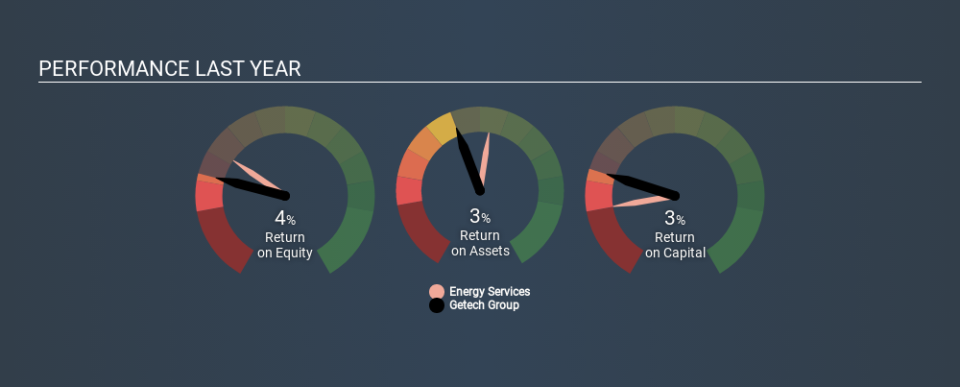Here’s why Getech Group Plc’s (LON:GTC) Returns On Capital Matters So Much

Today we'll look at Getech Group Plc (LON:GTC) and reflect on its potential as an investment. Specifically, we'll consider its Return On Capital Employed (ROCE), since that will give us an insight into how efficiently the business can generate profits from the capital it requires.
First of all, we'll work out how to calculate ROCE. Then we'll compare its ROCE to similar companies. Last but not least, we'll look at what impact its current liabilities have on its ROCE.
Return On Capital Employed (ROCE): What is it?
ROCE measures the amount of pre-tax profits a company can generate from the capital employed in its business. In general, businesses with a higher ROCE are usually better quality. Overall, it is a valuable metric that has its flaws. Renowned investment researcher Michael Mauboussin has suggested that a high ROCE can indicate that 'one dollar invested in the company generates value of more than one dollar'.
How Do You Calculate Return On Capital Employed?
Analysts use this formula to calculate return on capital employed:
Return on Capital Employed = Earnings Before Interest and Tax (EBIT) ÷ (Total Assets - Current Liabilities)
Or for Getech Group:
0.033 = UK£458k ÷ (UK£17m - UK£2.9m) (Based on the trailing twelve months to June 2019.)
Therefore, Getech Group has an ROCE of 3.3%.
View our latest analysis for Getech Group
Is Getech Group's ROCE Good?
When making comparisons between similar businesses, investors may find ROCE useful. In this analysis, Getech Group's ROCE appears meaningfully below the 13% average reported by the Energy Services industry. This performance is not ideal, as it suggests the company may not be deploying its capital as effectively as some competitors. Putting aside Getech Group's performance relative to its industry, its ROCE in absolute terms is poor - considering the risk of owning stocks compared to government bonds. There are potentially more appealing investments elsewhere.
We can see that, Getech Group currently has an ROCE of 3.3% compared to its ROCE 3 years ago, which was 0.03%. This makes us think about whether the company has been reinvesting shrewdly. You can click on the image below to see (in greater detail) how Getech Group's past growth compares to other companies.
Remember that this metric is backwards looking - it shows what has happened in the past, and does not accurately predict the future. Companies in cyclical industries can be difficult to understand using ROCE, as returns typically look high during boom times, and low during busts. ROCE is only a point-in-time measure. We note Getech Group could be considered a cyclical business. How cyclical is Getech Group? You can see for yourself by looking at this free graph of past earnings, revenue and cash flow.
What Are Current Liabilities, And How Do They Affect Getech Group's ROCE?
Current liabilities are short term bills and invoices that need to be paid in 12 months or less. Due to the way ROCE is calculated, a high level of current liabilities makes a company look as though it has less capital employed, and thus can (sometimes unfairly) boost the ROCE. To counteract this, we check if a company has high current liabilities, relative to its total assets.
Getech Group has total assets of UK£17m and current liabilities of UK£2.9m. As a result, its current liabilities are equal to approximately 17% of its total assets. With a very reasonable level of current liabilities, so the impact on ROCE is fairly minimal.
Our Take On Getech Group's ROCE
Getech Group has a poor ROCE, and there may be better investment prospects out there. Of course, you might also be able to find a better stock than Getech Group. So you may wish to see this free collection of other companies that have grown earnings strongly.
I will like Getech Group better if I see some big insider buys. While we wait, check out this free list of growing companies with considerable, recent, insider buying.
If you spot an error that warrants correction, please contact the editor at editorial-team@simplywallst.com. This article by Simply Wall St is general in nature. It does not constitute a recommendation to buy or sell any stock, and does not take account of your objectives, or your financial situation. Simply Wall St has no position in the stocks mentioned.
We aim to bring you long-term focused research analysis driven by fundamental data. Note that our analysis may not factor in the latest price-sensitive company announcements or qualitative material. Thank you for reading.

 Yahoo Finance
Yahoo Finance 
